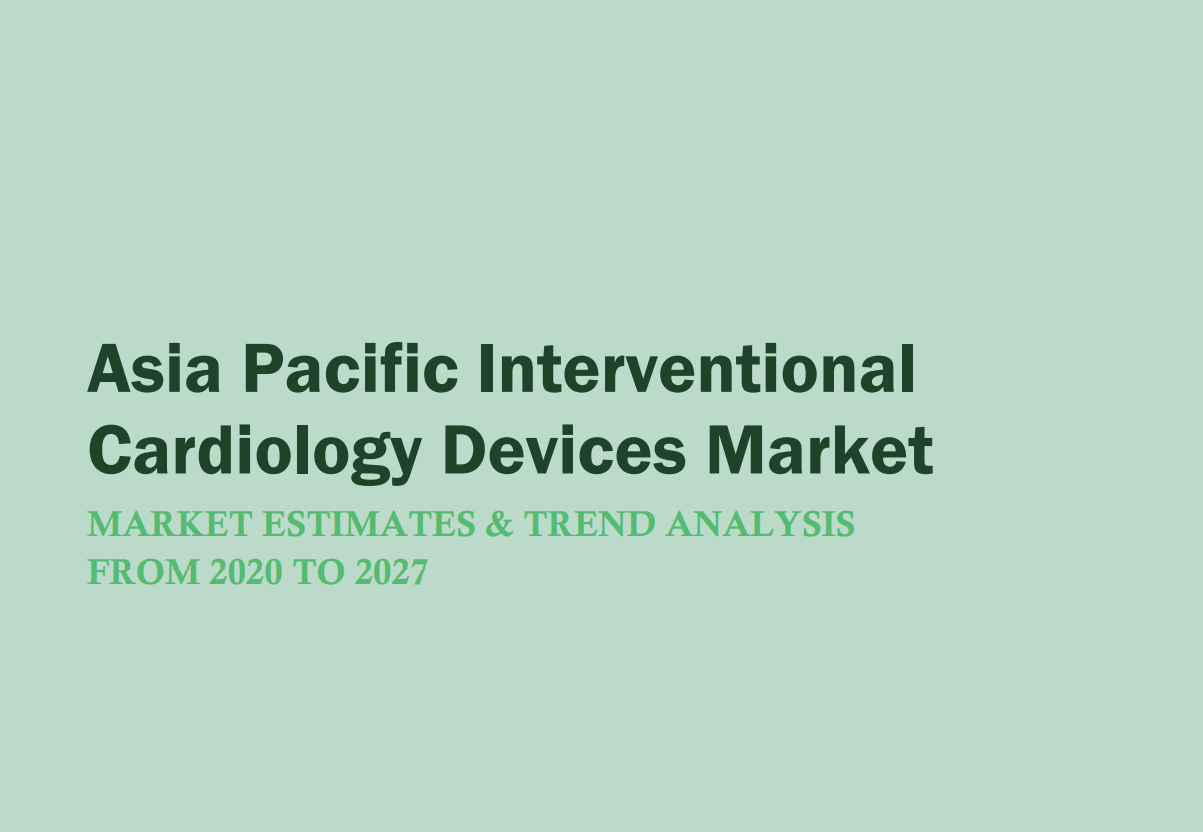The report covers 4 countries within Asia Pacific, segregated into four countries, India, China, Japan, and South Korea. These are the countries in Asia Pacific where the robust growth of interventional cardiology devices market adoption was observed in the past and is expected to register growth during the forecast period due to increasing Angiography procedures, supportive regulations and laws, and increasing awareness about healthcare procedures. Also, key drivers of all the countries are included in the report which indicates the favorable opportunities for companies to enter into these markets.

The Asia Pacific interventional cardiology devices market was valued at USD 4,268.5 Million in 2020 and is expected to grow at a CAGR of 3.9% over the forecast period. The changing insurance coverage coupled with rising awareness about patient benefits is expected to drive the market during the forecast period. Countries like China and India is developing price control program for these medical devices. This trend is expected to contribute to slower growth of interventional cardiology devices market in the foreseeable future. Presence of end-to-end manufacturers that are engaged in providing value-added services for minimum profit margins is expected to bolster growth.

Company Profiles
- BOSTON SCIENTIFIC
- MEDTRONIC
- ABBOTT
- NORDSON MEDICAL
- TERUMO CORPORATION
- COOK GROUP
- STENTYS SA

TABLE OF CONTENT
Table Of Contents
01 *Methodology and Scope
1.1 Market Segmentation & Scope
1.1.1 Product Type
1.1.2 Regional Scope
1.1.3 Estimates and Forecast Timeline
1.3 Information Procurement
1.3.1 Secondary Sources
1.3.2 Details of Primary Research
1.4 List of Abbreviations
02 Executive Summary
2.1 Market Outlook
2.2 Segment Outlook
03 Asia Pacific Interventional Cardiology Devices Market: Variables, Trends, & Scope
3.1 Asia Pacific Interventional Cardiology Devices Market: Key Market Development
3.2 Penetration & Growth Prospect Mapping
3.3 APAC Value Chain Analysis
3.4 Market Dynamics
3.4.1 Market Driver Analysis
3.4.1.1 Growing Geriatric Population and Healthcare Spending
3.4.1.2 Increased Prevalence of Cardiovascular Disease
3.4.1.3 Growing Number of Cardiac Catherization Labs
3.4.2 Market Restraint Analysis
3.4.2.1 Procedures volumes are down due to COVID19
3.5 Asia Pacific Interventional Cardiology Devices Market Analysis Tools
3.5.1 Porter’s Five Forces Analysis
3.5.2 Pestel Analysis
04 Asia Pacific Interventional Cardiology Devices Market: Product Type Segment Analysis
4.1 Asia Pacific Interventional Cardiology Devices: Market Share Analysis, 2020 & 2027
4.1.1 Interventional Cardiology Devices
4.1.1.1 Stents
4.1.1.1.1 Stents market, 2020-2027 (USD Million)
4.1.1.2 Interventional Catheters
4.1.1.3 PTCA Guidewires
4.1.1.3.1 PTCA Guidewires market, 2020-2027 (USD Million)
4.1.1.4 PTCA Balloons
4.1.1.4.1 PTCA Balloons market, 2020-2027 (USD Million)
4.1.1.5 Balloon Inflation Device
4.1.1.5.1 Balloon Inflation Device market, 2020-2027 (USD Million)
4.1.1.6 Cardiac Valve
4.1.1.6.1 Cardiac Valve Device market, 2020-2027 (USD Million)
05 Asia Pacific Interventional Cardiology Devices Market: Country Level Analysis
5.1 Asia Pacific Interventional Cardiology Devices: Regional Market Share
5.2 Asia Pacific Interventional Cardiology Devices: Market Share Analysis, 2020 & 2027
5.3 Asia Pacific
5.3.1 Asia Pacific Interventional Cardiology Devices Market, 2020 – 2027 (USD BILLION)
5.3.2 INDIA
5.3.2.1 India Interventional Cardiology Devices market, 2020 – 2027 (USD Million)
5.3.2.2 India SWOT Analysis
5.3.3 JAPAN
5.3.3.1 Japan Interventional Cardiology Devices market, 2020 – 2027 (USD Million)
5.3.3.2 Japan SWOT Analysis
5.3.4 CHINA
5.3.4.1 China Interventional Cardiology Devices market, 2020 – 2027 (USD Million)
5.3.4.2 China SWOT Analysis
5.3.5 SOUTH KOREA
5.3.5.1 South Korea Interventional Cardiology Devices market, 2020 – 2027 (USD Million)
5.3.5.2 South Korea SWOT Analysis
06 Company Profiles
6.1 BOSTON SCIENTIFIC
6.1.1 Company overview
6.1.2 Financial performance
6.1.3 Product benchmarking
6.1.4 Strategic initiatives
6.2 MEDTRONIC
6.2.1 Company overview
6.2.2 Financial performance
6.2.3 Product benchmarking
6.2.4 Strategic initiatives
6.3 ABBOTT
6.3.1 Company overview
6.3.2 Financial performance
6.3.3 Product benchmarking
6.3.4 Strategic initiatives
6.4 NORDSON MEDICAL
6.4.1 Company overview
6.4.2 Financial performance
6.4.3 Product benchmarking
6.4.4 Strategic initiatives
6.5 TERUMO CORPORATION
6.5.1 Company overview
6.5.2 Financial performance
6.5.3 Product benchmarking
6.5.4 Strategic initiatives
6.6 COOK GROUP
6.6.1 Company overview
6.6.2 Financial performance
6.6.3 Product benchmarking
6.6.4 Strategic initiatives
6.7 STENTYS SA
6.7.1 Company overview
6.7.2 Financial performance
6.7.3 Product benchmarking
6.7.4 Strategic initiatives
07 KOL Commentary- Primary Research Insights
7.1 KOREA
7.2 INDIA
7.3 CHINA
7.4 JAPAN
Research Methodology
The findings and conclusions of this report are based on information gathered from both primary and secondary research sources. The primary sources of information include industry association data, and in-depth interviews conducted with wide range of next generation sequencing companies and distributors. Primary research represents the bulk of research efforts, supplemented by extensive secondary research. We reviewed the key players annual reports, press releases and relevant documents for competitive analysis and market understanding.
Secondary sources include white papers, business journals, public financial proceedings and historical market data from various trade journals, technical writing, internet sources, and statistical data from government websites, trade associations and agencies. The market data is assessed and validated considering interrelated market attributes and the impact of global economic variables. This has proven to be the most reliable, effective and successful approach for obtaining precise market data, capturing industry participants’ insights, and recognizing business opportunities.
Secondary Research
The secondary research sources that are typically referred to include, but are not limited to:
- Company websites, annual reports, financial reports, broker reports, and investor presentations
- Internal and external proprietary databases, relevant patent and regulatory databases
- National government documents, statistical databases and market reports
- News articles, press releases and web-casts specific to the companies operating in the market
Primary Research
- It provides first-hand information on the market size, market trends, growth trends, competitive landscape, future outlook, etc.
- Helps in validating and strengthening the secondary research findings
- Further develops the analysis team’s expertise and market understanding
- Primary research involves E-mail interactions, telephonic interviews as well as face-to-face interviews for each market, category, segment and sub-segment across geographies
The participants who typically take part in such a process include, but are not limited to:
- Industry participants: CEOs, VPs, marketing/Construction Type managers, market intelligence managers and national sales managers
- Purchasing managers, technical personnel, distributors and resellers
- Outside experts: Valuation experts, research analysts specializing in specific markets
- Key opinion leaders specializing in different areas corresponding to different industry verticals




